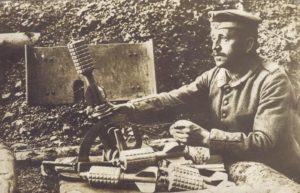Wednesday May 29th, 1918
Work morning T.M.B. Pit 7am to 11am. Raining and chilly. Warned for patrol – machine guns & 15 men – hope to come back safe and sound. Left 8pm Dorkley track while s carr ?? Goldies I, II, III and Claymore. Returned 2:45, tired but quite safe. French and Greeks go over on Vardar villages and prisoners.
Prisoner Interrogatory
Once again Frank is a member of a night patrol and once again it returns, thankfully safe but empty handed. The French and Greeks may or may not have had more success on the Vardar.
However yesterday, of his own volition, a Bulgar approached the British wire defences on Basin Hill and surrendered. Today he is interrogated and a report written, it becomes Appendix 4 of the War Diary. He belongs to the 7th Coy, 2nd Battalion of the 57th Regiment, IX (Plevna) Division. ‘He states that he does not agree with the policy of the present Bulgarian Government and states there are many who will desert.’
The prisoner provides a lot of seemingly useful information, starting with the locations and dispositions of the Companies and Battalions of the 57th, including its HQ. He also provides the Battalion strength of the 17th, 33rd, 34th, 39th, 57th and 58th Regiments and the enemy’s defensive arrangements for White Scar and Flat Iron Hill.
Enemy Weapons
The 57th Regiment has four machine gun companies of eight guns each. There are at least three trench mortar units and a searchlight on Devedzelli.

A company of Granatenwerfer is also attached to his regiment. The Granatenwerfer was a portable German WWI grenade thrower. Its projectiles carried a 14oz high explosive charge with a range of about 330 yards and rate of fire up to 4 or 5 a minute. With its base plate, the total weight was about 80 lbs. The photograph shows a German with both the Granatenwerfer and its missiles. The company comprises 260 rifles and 24 of these grenade throwers.
The enemy also have some listening apparatus near Saddle Hill. This could have been used for detecting approaching aircraft. Both sides developed a variety of listening devices both during and after the war. While they were made redundant with the arrival of radar, some of the designs were ingenious.²
Apparently both the 17th and 30th Regiment have Flammenwerfer which must have been a terrifying weapon to encounter. They could have been the M16, a German man-portable backpack flamethrower that was used during World War I in trench warfare. It was first used in combat in 1915 at Verdun and then at various battles throughout the war. The French developed something similar and Britain experimented with some designs but none went into mass production.³
The prisoner obviously provided useful, if disquieting, information to his British interrogators.
13th (Service) Battalion War Diary – 29th May 1918 – Sporan
There was the usual activity on both sides . Our planes patrolled the enemy lines five times during the day. Enemy planes were inactive. An enemy observation balloon went up at 17:25 hrs and descended at 18:40 hrs on the approach of four of our planes. Patrols saw and heard nothing of the enemy. Newly excavated earth was seen on Devedzelli Hill. 3 men were seen in trenches on Flat Iron Hill. Bombs are heard every evening in Krastali. As a recent raid on this place was carried out as soon after dusk as possible, one might presume that the enemy bombs his own trenches before occupying them to ensure their being clear of any of our troops.
References & Further Reading
¹ Granatenwerfer on Forgotten Weapons
* ibid, image may be subject to copyright
² Aircraft detection before radar on Rare Historical Photos
³ Flammenwerfer M16 on Wikipedia


